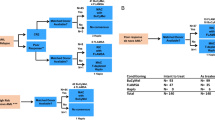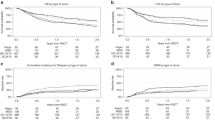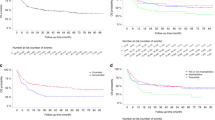Abstract
Acute myeloid leukaemia in the elderly is a disease with distinct biological properties, commonly associated with leukaemic cell treatment resistance and with an increased number of high-risk features, including concomitant myelodysplasia and poor-risk cytogenetic abnormalities such as monosomy 5 and 7. Complete remission rates after standard induction chemotherapy in patients above age 60 years are less than 50%, with long-term survival rates below 10%. Post-remission stem cell transplant therapies have not been studied extensively. Autologous transplants can result in an acceptable 3-year leukaemia-free survival rate of up to 47%, yet this procedure is applicable only to a small minority of patients. Myeloablative allogeneic transplants similarly show feasibility in selected few patients and in general are very toxic. Non-myeloablative allogeneic transplants are associated with reduced toxicity, but are plagued by an increased relapse rate. The latter strategy appears promising, but must be validated in larger, multi-centre prospective trials, in which outcomes are compared to non-transplant approaches.
This is a preview of subscription content, access via your institution
Access options
Subscribe to this journal
Receive 12 print issues and online access
$259.00 per year
only $21.58 per issue
Buy this article
- Purchase on Springer Link
- Instant access to full article PDF
Prices may be subject to local taxes which are calculated during checkout
Similar content being viewed by others
References
Fialkow PJ, Singer JW, Adamson JW, Vaidya K, Dow LW, Ochs J et al. Acute nonlymphocytic leukemia: heterogeneity of stem cell origin. Blood 1981; 57: 1068–1073.
Brincker H . Population-based age- and sex-specific incidence rates in the 4 main types of leukemia. Scand J Hematol 1982; 29: 241–249.
Preiss BS, Kerndrup GB, Schmidt KG, Sorensen AG, Clausen NA, Gadeberg OV et al. Cytogenetic findings in adult de novo acute myeloid leukaemia. A population-based study of 303/337 patients. Br J Hematol 2003; 123: 219–234.
Feldman EJ . Acute myelogenous leukemia in the older patient. Semin Oncol 1995; 22 (1 Suppl 1): 21–24.
Pulsoni A, Pagano L, Latgaliata R, Casini M, Cerri R, Crugnola M et al. Survival of elderly patients with acute myeloid leukemia. Haematologica 2004; 89: 296–302.
Schoch C, Kern W, Schnittger S, Buchner T, Hiddemann W, Haferlach T et al. The influence of age on prognosis of de novo acute myeloid leukemia differs according to cytogenetic subgroups. Haematologica 2004; 89: 1082–1090.
Stone RM . The difficult problem of acute myeloid leukemia in the older adult. CA Cancer J Clin 2003; 52: 363–371.
Baudard M, Marie JP, Cadiou M, Viguie F, Zittoun R . Acute myelogenous leukemia in the elderly. Retrospective study of 235 consecutive patients. Br J Hematol 1994; 86: 82–91.
Hiddeman W, Kern W, Schoch C, Fonatsch C, Heinecke A, Wormann B et al. Management of acute myeloid leukemia in elderly patients. J Clin Oncol 1999; 17: 3569–3576.
Harousseau JL . Acute myeloid leukemia in the elderly. Blood Rev 1998; 12: 145–153.
Manoharan A . Acute myeloblastic leukemia in the elderly; biology, prognostic factors and treatment. Int J Hematol 1998; 68: 235–243.
Leith CP, Kopecky KJ, Godwin J, McConnell T, Slovak ML, Chen IM et al. Acute myeloid leukemia in the elderly: assessment of multidrug resistance and cytogenetics distinguishes biologic subgroups with remarkably distinct responses to standard chemotherapy. A SWOG study. Blood 1997; 89: 3323–3329.
Banker DE, Groudine M, Norwood T, Appelbaum FR . Measurement of spontaneous and therapeutic agent induced apoptosis with BCL2 protein expression in acute myeloid leukemia. Blood 1997; 89: 243–255.
Mayer RJ, Davis RB, Schiffer CA, Berg DT, Powell BL, Schulman P et al. Intensive post remission chemotherapy in adults with acute myeloid leukemia. CALGB. N Engl J Med 1994; 331: 896–903.
Appelbaum FR, Gundacker H, Head Dr, Slovak ML, Willman CL, Godwin JE et al. Age and acute myeloid leukemia. Blood 2006; 107: 3481–3485.
Grimwade D, Walker H, Harrison G, Oliver F, Chatters S, Harrison CJ et al. The predictive value of hierarchical cytogenetic classification in older adults with acute myeloid leukemia. Analysis of 1065 patients entered into the United Kingdom Medical Research Council AML 11 trial. Blood 2001; 98: 1312–1320.
List AF, Spier SC, Grogan TM, Johnson C, Roe DJ, Greer JP et al. Overexpression of the major vault transporter protein lung resistance protein predicts treatment outcome in acute myeloid leukemia. Blood 1996; 87: 2464–2469.
Leith CP, Kopecky KJ, Chen IM, Eijdems L, Slovak ML, McConnell TS et al. Frequency and clinical significance of the expression of the multidrug resistance proteins MDR1/P glycoprotein, MRP1 and LRP in acute myeloid leukemia. A SWOG study. Blood 1999; 94: 1086–1099.
Zhu YM, Das Gupta EP, Russel NH . Microsatellite instability and p53 mutations are associated with abnormal expression of the MSH gene in adult acute leukemia. Blood 1999; 94: 733–740.
Lichtman MA, Rowe JM . The relationship of patient age to the pathobiology of the clonal myeloid diseases. Semin Oncol 2004; 31: 185–197.
Sekeres M, Stone RM . The challenge of acute myeloid leukemia in older patients. Curr Opin Oncol 2002; 14: 24–30.
Tilly H, Castaigne S, Bordessoule D, Casassus P, Le Prise PY, Tertian G et al. Low-dose cytarabine versus intensive chemotherapy in the treatment of acute nonlymphocytic leukemia in the elderly. J Clin Oncol 1990; 8: 272–279.
Lowenberg B, Zittoun R, Kerkhofs H, Jehn U, Abels J, Debusscher L et al. On the value of intensive remission-induction chemotherapy in elderly patients of 65+ years with acute myeloid leukemia: a randomized phase III study of the European Organization for Research and Treatment of Cancer Leukemia Group. J Clin Oncol 1989; 7: 1268–1274.
Pelizzari AM, Drera M, D'Adda M, Ungari M, Marocolo D, Facchetti F et al. Recombinant granulocyte colony stimulating factor as treatment for poor prognosis oligoblastic acute myeloid leukemia in elderly patients. Haematologica 2007; 92: 106–109.
Deschler B, de Witte T, Mertelsmann R, Lubbert M . Treatment decision making for older patients with high risk myelodysplastic syndrome or acute myeloid leukemia: problems and approaches. Haematologica 2006; 91: 1513–1522.
Stone RM, Berg DT, George SL, Dodge RK, Paciucci PA, Schulman PP et al. Postremission therapy in older patients with de novo acute myeloid leukemia: a randomized trial comparing mitoxantrone and intermediate dose cytarabine with standard dose cytarabine. Blood 2001; 98: 548–553.
Kantarjian H, OBrien S, Cortes J, Giles F, Faderl S, Jabbour E et al. Results of intensive chemotherapy in 998 patients age 65 or older with acute myeloid leukemia or high risk myelodysplastic syndrome. Cancer 2006; 106: 1090–1098.
Lowenberg B, Suciu S, Archimbaud E, Haak H, Stryckmans P, de Cataldo R et al. Mitoxantrone versus daunorubicin in induction consolidation chemotherapy the value of low dose cytarabine for maintenance of remission and an assessment of prognostic factors in acute myeloid leukemia in the elderly: final report. J Clin Oncol 1998; 16: 872–881.
Burnett AK, Goldstone AH, Stevens RM, Hann IM, Rees JK, Gray RG et al. Randomised comparison of addition of autologous bone marrow transplantation to intensive chemotherapy for acute myeloid leukemia in first remission. Results of the MRC AML10 trial. Lancet 1998; 351: 700–708.
Cassileth PA, Harrington DP, Appelbaum FR, Lazarus HM, Rowe JM, Paietta E et al. Chemotherapy compared with autologous or allogeneic bone marrow transplantation in the management of acute myeloid leukemia in first remission. N Engl J Med 1998; 339: 1649–1656.
Zittoun RA, Mandelli F, Willemze R, de Witte T, Labar B, Resegotti L et al. Autologous or allogeneic bone marrow transplantation compared with intensive chemotherapy in acute myelogenous leukemia. N Engl J Med 1995; 332: 217–223.
Harousseau JL, Cahn JY, Pignon B, Witz F, Milpied N, Delain M et al. Comparison of autologous bone marrow transplantation and intensive chemotherapy as postremission therapy in adult patients with acute myeloid leukemia. Blood 1997; 90: 2978–2986.
Gorin N . Autologous stem cell transplantation for adult acute leukemia. Curr Opin Oncol 2002; 14: 152–159.
Mazza P, Palazzo G, Amurri B, Cervellera M, Manna N, Fellini G et al. Analysis of feasibility of myeloablative therapy and autologous peripheral stem cell transplantation in the elderly: an interim report. Bone Marrow Transplant 1999; 23: 1273–1278.
de la Rubia J, Saavedra S, Sanz GF, Martin G, Moscardo F, Martinez J et al. Transplant related mortality in patients older than 60 years undergoing autologous hematopoietic stem cell transplantation. Bone Marrow Transplant 2001; 27: 21–25.
Moreau P, Milpied N, Voillat L, Colombat P, Mahe B, Rapp MJ et al. Peripheral blood stem cell transplantation as front line therapy in patients aged 61–65 years: a pilot study. Bone Marrow Transplant 1998; 21: 1193–1196.
Cahn JY, Labopin M, Mandelli F, Goldstone AH, Eberhardt K, Reiffers J et al. Autologous bone marrow transplantation for first remission acute myeloblastic leukemia in elderly patients: a retrospective analysis of the European group for blood and marrow transplantation (EBMT). Blood 1995; 85: 575–579.
Gorin NC, Labopin M, Pichard P, Sierra J, Fiere D, Rio B et al. Feasibility and recent improvement of autologous stem cell transplantation for acute myelocytic leukemia in patients over 60 years of age: importance of the source of stem cells. Br J Haematol 2000; 110: 887–893.
Ferrara F, Venditti A, Carellajr AM, Cantore N, Buccisano F, Tamburini A et al. Autologous stem cell transplantation for patients with acute myeloid leukemia aged over 60 years. Eur J Haematol 2002; 69: 200–204.
Archimbaud E, Jehn U, Thomas X, De Cataldo F, Fillet G, Belhabri A et al. Multicenter randomized phase II trial of idarubicin vs mitoxantrone combined with VP16 and cytarabine for induction/consolidation therapy followed by a feasibility study of autologous peripheral blood stem cell transplantation in elderly patients with acute myeloid leukemia. Leukemia 1999; 13: 843–849.
Oriol A, Ribera JM, Esteve J, Guardia R, Brunet S, Bueno J et al. Feasibility and results of autologous stem cell transplantation in de novo acute myeloid leukemia in patients over 60 years old. Results of the CETLAM AML 99 protocol. Hematologica 2004; 89: 791–800.
Montillo M, Tedeschi A, Pagano L, Venditti A, Ferrara F, Fabris P et al. Feasiblity of peripheral blood stem cell rescue as intensification in elderly patients with acute myelocytic leukemia: a pilot study from the GIMEMA group. Br J Haematol 2000; 111: 334–337.
Ferrara F, Palmieri S, Celentano M, De Simone M, Pollio F, D'Amico MR et al. Feasibility of autologous peripheral blood stem cell transplantation in elderly patients with acute myeloid leukemia. Leuk Lymphoma 2006; 57: 1593–1598.
Wallen H, Gooley TH, Deeg HJ, Pagel JM, Press OW, Appelbaum FR et al. Ablative allogeneic hematopoietic cell transplantation in adults 60 years of age and older. J Clin Oncol 2005; 23: 3439–3446.
Ditschkowski M, Elmaagacli AH, Trenschel R, Steckel NK, Koldehoff M, Beelen DW . Myeloablative allogeneic hematopoietic stem cell transplantation in elderly patients. Clin Transplant 2006; 20: 127–131.
Alyea E, Kim HT, Ho V, Cutler C, Gribben J, DeAngelo DJ et al. Comparative outcome of nonmyeloablative and myeloablative allogeneic hematopoietic stem cell transplantation for patients older than 50 years of age. Blood 2005; 105: 1810–1814.
de Lima M, Giralt S . Allogeneic transplantation for the elderly patient with acute myelogenous leukemia or myelodysplastic syndrome. Semin Hematol 2006; 43: 107–117.
Aoudjhane M, Labopin M, Gorin NC, Shimoni A, Ruutu T, Kolb HJ et al. Comparative outcome of reduced intensity and myeloablative conditioning regimen in HLA identical sibling allogeneic hematopoietic stem cell transplantation for patients older than 50 years with acute myeloablastic leukemia: a retrospective survey from the acute leukemia working party of the European group for blood and marrow transplantation. Leukemia 2005; 19: 2304–2312.
McSweeney PA, Niederwieser D, Shizuru JA, Sandmaier BM, Molina AJ, Maloney DG et al. Hematopoietic cell transplantation in older patients with hematologic malignancies: replacing high dose cytotoxic therapy with graft versus tumor effects. Blood 2001; 97: 3390–3400.
Feinstein L, Sandmaier B, Hegenbart U, McSweeney PA, Maloney DG, Gooley TA et al. Non myeloablative allografting from human leucocyte antigen identical sibling donors for treatment of acute myeloid leukemia in first complete remission. Br J Haematol 2003; 120: 281–288.
Martino R, Caballero MD, Simon JA, Canals C, Solano C, Urbano-Ispizua A et al. Evidence for a graft versus leukemia effect after allogeneic peripheral blood stem cell transplantation with reduced intensity conditioning in acute myeloid leukemia and myelodysplastic syndromes. Blood 2002; 15: 2243–2245.
Martino R, Perez-Simon JA, Moreno E, Queralto JM, Caballero D, Mateos M et al. Reduced intensity conditioning allogeneic blood stem cell transplantation with fludarabine and oral busulfan with or without pharmacokinetically targeted busulfan dosing in patients with myeloid leukemia ineligible for conventional conditioning. Biol Blood Marrow Transplant 2005; 11: 437–447.
Bertz H, Potthoff K, Finke J . Allogeneic stem cell transplantation from related and unrelated donors in older patients with myeloid leukemia. J Clin Oncol 2003; 21: 1480–1484.
Spyridonidis A, Bertz H, Ihorst G, Grullich C, Finke J . Hematopoietic cell transplantation from unrelated donors as effective therapy for older patients with active myeloid malignancies. Blood 2005; 105: 4147–4148.
Hegenbart U, Nierderwieser D, Sandmaier BM, Maris MB, Shizuru JA, Greinix H et al. Treatment for acute myelogenous leukemia by low dose TBI based conditioning and hematopoietic cell transplantation from related and unrelated donors. J Clin Oncol 2006; 24: 444–453.
Gupta V, Daly A, Lipton J, Hasegawa W, Chun K, Kamel-Reid S et al. Nonmyeloablative stem cell transplantation for myelodysplastic syndrome or acute myeloid leukemia in patients 60 years or older. Biol Blood Marrow Transplant 2005; 11: 764–772.
Wong R, Giralt S, Martin T, Couriel DR, Anagnostopoulos A, Hosing C et al. Reduced intensity conditioning for unrelated donor hematopoietic stem cell transplantation as treatment for myeloid malignancies in patients older than 55 years. Blood 2003; 102: 3052–3059.
de Lima M, Anagnostopoulos A, Munsell M, Shahjahan M, Ueno N, Ippoliti C et al. Nonablative versus reduced intensity conditioning regimens in the treatment of acute myeloid leukemia and high risk myelodysplastic syndrome: dose is relevant for long term disease control after allogeneic hematopoietic stem cell transplantation. Blood 2004; 104: 865–872.
Estey E, de Lima M, Tibes R, Pierce S, Kantarjian H, Champlin R et al. Prospective feasibility analysis of reduced intensity conditioning regimens for hematopoietic stem cell transplantation in elderly patients with acute myeloid leukemia and high risk myelodysplastic syndrome. Blood 2007; 109: 1395–1400.
Song KW, Lipton J . Is it appropriate to offer allogeneic hematopoietic stem cell transplantation to patients with refractory acute myeloid leukemia. Bone Marrow Transplant 2005; 35: 183–191.
Schmid C, Shleunig M, Schwerdtfeger R, Hertenstein B, Mischak-Weissinger E, Bunjes D et al. Long term survival in refractory acute myeloid leukemia after sequential treatment with chemotherapy and reduced intensity conditioning for allogeneic stem cell transplantation. Blood 2006; 108: 1092–1099.
Claxton DF, Ehmann C, Rybka W . Control of advanced and refractory acute myeloid leukemia after sequential treatment with chemotherapy and reduced intensity conditioning for allogeneic stem cell transplantation. Blood 2006; 108: 1092–1099.
Tauro S, Craddock C, Peggs K, Begum G, Mahendra P, Cook G et al. Allogeneic stem cell transplantation using a reduced intensity conditioning regimen has the capacity to produce durable remissions and ling term disease free survival in patients with high risk acute myeloid leukemia and myelodysplasia. J Clin Oncol 2005; 23: 9387–9393.
Popat U, Heslop HE, Durett A, May R, Krance RA, Brenner MK et al. Outcome of reduced intensity allogeneic hematopoietic stem cell transplantation using antilymphocyte antibodies in patients with high risk acute myeloid leukemia. Bone Marrow Transplant 2006; 37: 547–552.
Kroger N, Shimoni A, Zabelina T, Schieder H, Panse J, Ayuk F et al. Reduced toxicity conditioning with treosulfan, fludarabine and ATG as preparative regimen for allogeneic stem cell transplantation in elderly patients with secondary acute myeloid leukemia or myelodysplastic syndrome. Bone Marrow Transplant 2006; 37: 339–344.
Gale R, Bortin M, van Bekkum D, Biggs JC, Dicke KA, Gluckman E et al. Risk factors for acute graft versus host disease. Br J Haematol 1987; 67: 397–406.
Wong JYC, Liu A, Schultheiss T, Parker P, Krishnan A, Sahebi F et al. Total marrow irradiation (TMI) using helical tomotherapy: dosimetric analysis demonstrates reduced organ doses which correlate with reduction in acute toxicities and predict for escalation of dose to target marrow beyond that achievable by standard TBI (abstract #21). Biol Blood Marrow Transplant 2007; 13: 10.
Luznik L, Fuchs EJ, Chen AR, Kaup M, Bright EC, Bolanos-Meade J et al. Post-transplantation high-dose cyclophosphamide (Cy) is effective single agent GVHD prophylaxis that permits prompt immune reconstitution after myeloablative HLA matched related and unrelated bone marrow transplantation (BMT) (abstract #6). Biol Blood Marrow Transplant 2007; 13: 4.
Author information
Authors and Affiliations
Corresponding author
Rights and permissions
About this article
Cite this article
Kiss, T., Sabry, W., Lazarus, H. et al. Blood and marrow transplantation in elderly acute myeloid leukaemia patients – older certainly is not better. Bone Marrow Transplant 40, 405–416 (2007). https://doi.org/10.1038/sj.bmt.1705747
Received:
Accepted:
Published:
Issue Date:
DOI: https://doi.org/10.1038/sj.bmt.1705747
Keywords
This article is cited by
-
Prognostic factors in allo-SCT of elderly patients with AML
Bone Marrow Transplantation (2011)



